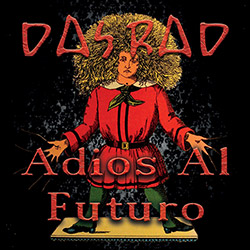
Das Rad consists of Martin Archer, Nick Robinson and Steve Dinsdale. These musicians all partake in the rich history of progressive rock within England. The group refer to their unique brand of progressive rock as "improg." In my eyes, it is this improvisational character of their music that gives it a unique vitality. Das Rad are — fundamentally — fervid. This vitality often goes amiss in the works of other progressive rock groups, who often systematize and over conceptualize their music.
The vitality of Adios al Futuro becomes immediately apparent from the opening track. "Inside Reverse" begins with supple and gentle saxophone arpeggios, dancing over a shimmering foundation of electronica. The skittish and supple instrumentation alternates between dissonance and harmony; petulance pulsates to calm. Archer's saxophone explores and muses over these throbbing tones (this is a feature throughout much of the album). Ringing synth leads mark the next passage. A guitar barges into the fore, growling with distortion and contempt. Woodwind and electronica all coalesce to form a Greek Chorus, deriding Robinson's guitar which shrieks out in abject animosity. The track crescendos into a windwood attuned, percussion lead, guitar fettered wall. Quasi-glitch electronica marks the denouement of this track.
"Deuce of Gears" is typified by haunting electronica interspersed with rattling percussive hits. Dormant and latent electronica stir and pulse into life before giving up the ghost and returning to their stupor. Each instrument in this track is tentative about making the first move. An aura of caution surrounds this sonic space: there are a collection of half-attempts to start conversation. Instruments stutter and splutter, thinking of things to say. The total paucity of harmony becomes more uncanny and unsettling as these attempts to converse fail, again and again. This is a track of absence, rather than presence; "Deuce of Gears" is a sonic 'hauntology'.
Then the titular track, "Adios Al Futuro". Palpitating chords are attuned by chromatic notes which are juxtaposed with fluttering woodwind instrumentation. This woodwind ensemble both unionizes and divides as the track progresses. They act as both one cohesive sonic mosaic and individual elements. This constant flux between unity and singularity provides great swells and dispersions. These sonic interplays between registers create a sonic blanket of texture.
"Eisblume" provides a moment of equanimity. A moment of acoustic no-man's-land. This moment of rest is afforded to the listener through dancing plucked arpeggios and sequences. Archer's saxophone once again is the diamond in this piece: it operates over this delicate sonic web and speaks its truth. The playing is subtle such that it never pierces this web: it maintains poise and pomp.
"Another Place" continues this turn to ambience. Tremolo guitar scales arise from, and sink back into, the jigsaw-like foundations of this serene piece. Synth leads provide the layers for free play. Archer's saxophone is slowly coaxed out of its momentary hibernation, much like a dozing animal, only for it to explode into atavistic jubilation. Waves of smooth, glistening notes roll like undulating hills which gently stroke the azure. The excellence of Archer's saxophone playing is most apparent on this song.
"Tiefes Blau" provides a fitting conclusion. Das Rad, ending as they mean to go on, reify and tie up all the sonic themes that permeate this album. The shimmering riffs and haunting chromatic notes, the resonant and voluptuous saxophone, and the ever-present and metronomic drumming all continue their now well-established roles. However, these instruments keep their sonic edge. This is a testament to the vital nature of Das Rad's improg. These instruments remain as encapsulating and as intriguing as they were from the first minute of this album.
As progressive rock goes, Das Rad in Adios Al Futuro provides one of the most accessible — whilst also captivating — albums I have heard. This music is off-the-cuff and fundamentally extemporaneous. At no point are there moments of sonic stagnation or delay; each corner and enclave of this sonic landscape possess a luster that cannot be ignored. Das Rad offers the most charming elements of progressive rock. There is no hint of grandiose reasoning behind the music. It simply exists because it does.
Comments and Feedback:



More Recent Reviews, Articles, and Interviews @ The Squid's Ear...


| 
